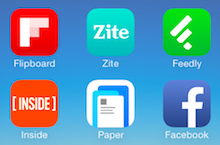Paper, the first app from Facebook’s Creative Labs available now for iPhones, could challenge Flipboard, Zite and Feedly in the business of aggregating news on mobile devices. Not only does it beautify your Facebook newsfeed, but it also links to content from major news sources in various sections like Headlines (news), Score (sports), Exposure (photos) and Planet (science and sustainability). Here are some reasons Paper might be the news reader for you (or not):
Pictures feel bigger (but not always better)
Almost all screens, from movie theaters to TVs to computers to tablets, are horizontal for a reason (tablet users seem to prefer the landscape orientation to portrait, but of course it’s used both ways). So it’s often frustrating to view our horizontal world through the tiny vertical window of a phone. Pinch-to-zoom works OK for seeing more detail, but the multitouch gesture is a little cumbersome and, of course, zooming makes it impossible to see the entire image at once.

- Paper’s tilt-to-pan function sometimes misses the mark, as in this photo of Philip Seymour Hoffman that isn’t improved by automatic zooming.
Paper offers an interesting solution to the problem of awkward mobile photo exploration by automatically zooming in on images and allowing users to pan left or right by tilting their phones. That makes for a cool immersive experience when viewing photos of scenes such as this one, with Kenyan police raiding a mosque.
But other times the feature feels gimmicky, disorienting and arbitrary. Is it really necessary for me to tilt my phone if I want to see either of Philip Seymour Hoffman’s ears? A simple tap of the photo brings up the full, letterboxed view, but I’m not convinced a zoomed-in, full-screen image is always the best way to come across new photos, even on a small screen. In the future, hopefully Paper can develop a way to employ the tilt-to-pan feature only when it makes sense.
Navigation is fun and mostly intuitive (but a little slow)
Paper’s lengthy, audio-narrated guide when first opening the app made me worry about how complex the app’s navigation would be, but the layered navigation was easy to get the hang of. There are no “X” buttons or “done” buttons to get in the way of viewing content, just swipes to dive deeper into content or swipes to dismiss it. Exploring the app’s layers was intuitive in ways exploring Inside.com for the first time wasn’t.

- While this view in the Paper app allows readers to see more than one story at once, zoomed-out story cards at the bottom of the screen are practically unreadable.
Yet the story-selection process itself isn’t as pleasurable as it is in other apps. In single-story view, for instance, you lose the the quick-browsing advantage of flicking your finger to scroll through your newsfeed in Facebook’s primary app. Each story has to be evaluated and considered in isolation before you flip to the next one, slowing down the process of zeroing in on the content you really want.
Each piece of content, from a status update to a shared photo to a link to a news story, gets its own story card taking up the entire screen. Jumping back a layer in Paper does allow you to see a carousel of zoomed-out story cards (see screenshot), but the photos and type are hopelessly tiny. Feedly, Zite and Flipboard all allow more than one legible piece of content on the screen at once, providing more on-screen choice and requiring less thumb action.
It’s very social (but only when it comes to Facebook)
One beauty of Zite, the smart aggregator owned by CNN, is that I can thumbs-up or thumbs-down stories without worrying about anyone but the algorithm knowing what a sucker I am for fake Apple product mock-ups or statistical analyses of Peyton Manning’s legacy. At the same time, if I want to share what I read via Facebook, Twitter, or Google+, it’s easy to do so. But Paper, naturally, is all about Facebook, so likes are public and you can’t even tweet from the app.
(To be fair, the official Twitter app doesn’t exactly facilitate posting to Facebook, either. You can always link your Facebook account to Twitter and vice versa, but the platforms often demand different types of sharing, limiting the usefulness of posting the same content simultaneously.)
That Paper is so intensely Facebook-centric brings all the advantages of in-app commenting on stories, engaging with friends and seeing which news stories are most popular according to more than a billion users. But as a pure news aggregator it falls short of multi-platform sharing functionality of Zite, Flipboard, Feedly and Inside. If you’re a Facebook junkie and want a little bit of aggregated news on the side, Paper could become the only Facebook app and only news app you need. But it’s no major threat to Flipboard and the like yet.






